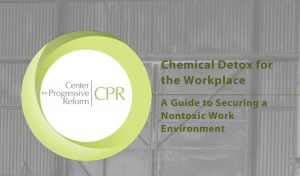The CPR Aims to Make Work Safer
In April, the Center for Progressive Reform (CPR) released a guide intended to help workers and employers achieve a “nontoxic workplace.”
The guide, Chemical Detox for the Workplace: A Guide to Securing a Nontoxic Work Environment, features resources on chemical hazards.
The advocacy group published it with the goal of empowering employers and workers to make changes beyond standard requirements.
Recent Article: How to Choose the Right Corporate Wellness Program
The CPR recommends moving faster than the EPA and OSHA to secure a safer and healthier work environment.
“Agencies like OSHA and EPA encounter serious obstacles when developing workplace protections against toxic substances,” Thomas McGarity, guide co-author and CPR board member.
“Even when they have overwhelming scientific evidence of significant health risks. The difficulty results not from a lack of data, but from intense lobbying from well-funded industries.”
Breaking Down the Nontoxic Work Environment Guide
The guide is divided into three sections.
Section One: Provides a list of tactics for employers to use to reduce toxic risks and assist injured workers.
Section Two: The guide gives readers an overview of the federal laws connected to toxic chemicals. This includes the Occupational Safety and Health Act. It also contains environmental laws designed to provide remedies for exposed workers.
Section Three: Includes the best resources available to help identify, and to take action to reduce, chemical hazards in the workplace. It contains several databases created for employers to research the chemicals used in their workplace.
Toxic Work Environments & Health Issues
An estimated 50,000 U.S. die every year from work-related health issues.
Most of those result from toxic chemical exposures.
Recent Article: Tick Bites Lead to Rise in Worker Illness
Workers who are at an increased risk of chemical exposure includes:
- agricultural workers;
- domestic cleaners;
- hair and nail specialists;
- home repairers;
- building construction workers;
- and chemical manufacturers.
“Although the guide does not cover every issue or situation workers may face, it is our hope that it will assist with identifying the appropriate questions to ask; initiating research on chemicals of concern in the workplace; and collaborating with other workers, unions and local organizers to take action,” said Sidney Shapiro, co-author and CPR board member.
Interested in learning more about how to use this guide to your workplace’s advantage?
CPR is scheduled to host a webinar on May 8 at 1 p.m. EST.
You can register for that event by clicking HERE.
Medical Surveillance Testing
Employers should be proactive about hazards in their workplaces. In most cases, it’s required.
Toxic chemical and substance exposure requires medical surveillance testing to assess underlying health & safety issues.
Related Article: The Benefits of Mobile Medical Testing
Worksite Medical makes it convenient with on-site medical testing.
With the full resources of a lab, we offer respirator fit testing, audiometric exams, bloodwork, physical exams and even online respirator clearance questionnaires.
Complete the form below to get a free quote or schedule, or call us at 1-844-OCCUMED.




